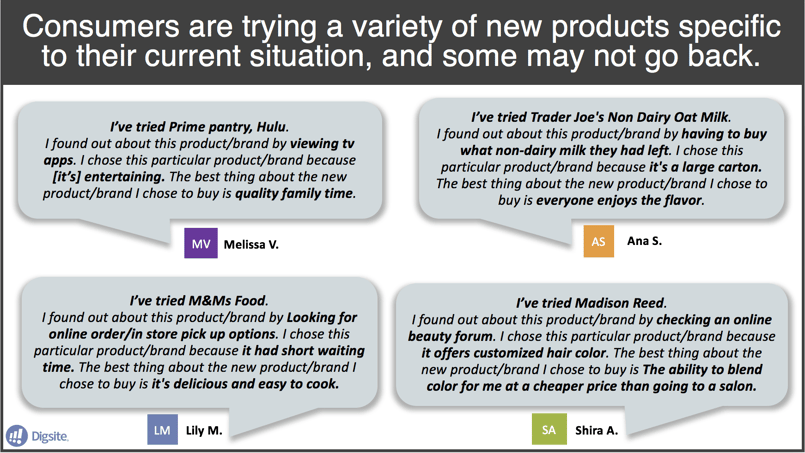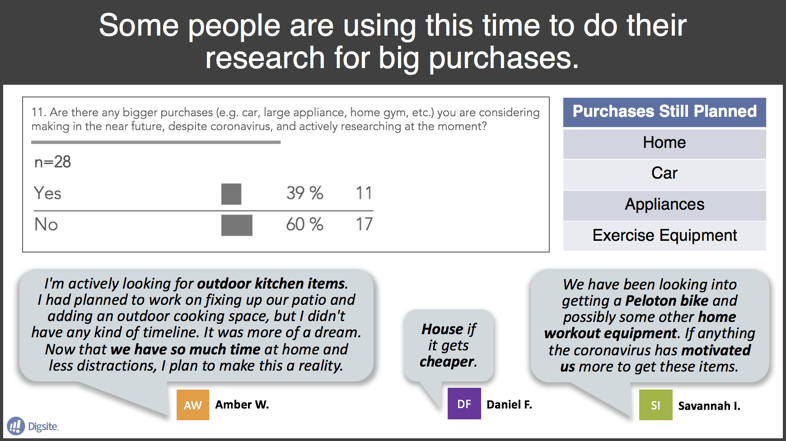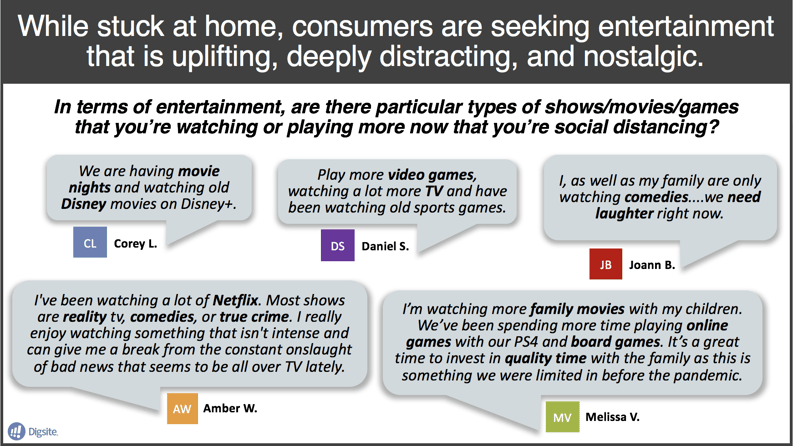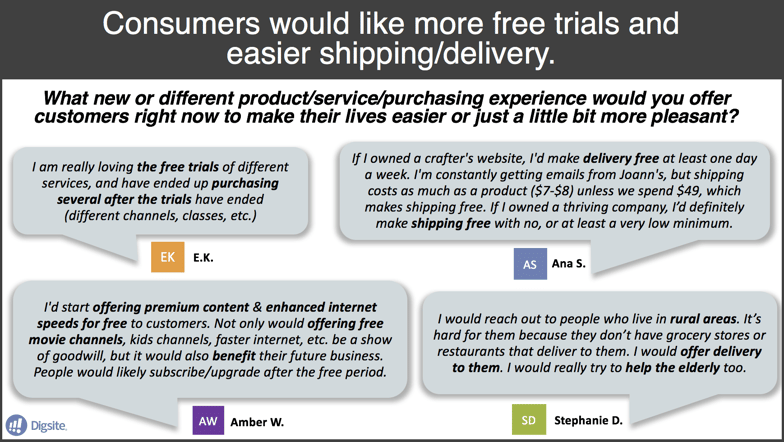We are now many months into our new reality of sheltering in place and social distancing during the COVID-19 crisis. How are consumer shopping and purchasing behavior evolving, and more importantly what behaviors are likely to "stick"? As an online qualitative technology solution, we used our platform to conduct rapid, in-context qualitative research to help brands build a deeper understanding of how they can strategically adjust products and messaging to meet changing consumer needs.
Our latest research brought 28 people into a two-day Digsite Sprint community where they were able to chat, share videos about their experiences, and respond to ideas. The group included males and females ages 21 to 60, with a mix of ethnicities and U.S. regions, all of whom have purchased at least one new product, service, or brand since social distancing became a reality.
Consider these six key findings as you think about ways to offer new products and services or reach new consumer audiences during COVID-19.
1. Consumers are buying a wide variety of new products and services
Consumers are researching and buying new products for a variety of reasons, often finding the new choices to be as good as, or better than, what they purchased in the past.
Here are some of the specific products – and reasons – mentioned by our research participants.
Products that allow for social distancing
- HelloFresh meal kit delivery service
- Microsoft Teams for online work and meetings
- M&M Food Market frozen food
- Amazon.com delivery of perishable foods like sour cream
- Madison Reed customized DIY hair color
Substitutions for familiar products
- Burt’s Bees Conditioning Lip Scrub – substitution found at Target, in place of a more expensive lip scrub that would have required an additional shopping trip
- Cascade ActionPacs – substitution for powdered dishwasher detergent
- Trader Joe’s Oat Beverage – substitution for another brand of non-dairy milk
New products that provide comfort
- Bigelow Sweet Dreams Herbal Tea and Yogi Soothing Caramel Bedtime Tea to help with falling sleep
- Outdoor basketball to relieve stress and replace playing basketball at the gym
- Decorative couch pillows to make the living room more inviting while working from home

Key takeaway: Offering products that enable social distancing, replace hard-to-find items, or allow additional comfort or escape could help drive growth for brands.
2. Not everyone is putting off big-ticket purchases
While the appetite for bigger-ticket items is quelled, some consumers are forging ahead with high-priced purchases, many of which they had not considered before COVID-19.
Here are some of the specific products mentioned by our research participants.
Purchases being considered
- Outdoor kitchen
- Peloton bike and other home workout equipment
Purchases on hold
- Mattress—wants to be able to be in store to test it out before buying
- Car
- River cruise vacation

Key takeaway: Providing ways to help consumers dream about, plan for and experience big-ticket items from home could build demand for online purchases typically made in-store.
3. Consumers are looking for in-home “escapism” entertainment
They're watching TV and playing games, both real and distanced, that let them connect with others and take a break from current reality.
Here are some of the specific types of entertainment mentioned by our research participants.
- Old Disney movies on Disney+ (for “family movie nights”)
- Comedies (“We need laughter right now.”)
- Family genre movies
- Old sports games
- Netflix series: Reality TV, comedies, true crime (“I really enjoy watching something that isn’t intense and gives me a break from the constant onslaught of bad news that seems to be all over TV lately.”)
- Online video games
- Board games (“It’s a great time to invest in quality time with the family, as this is something we were limited in before the pandemic.”)

Key takeaway: Advertisers and entertainment brands have tremendous opportunities to engage with consumers and provide them the escape they crave.
4. More free trials, please
Free trials of classes, channels and services give consumers a way to try new things risk-free. Not only does this help provide variety and help pass the time during social distancing, it removes the barrier of trying something they wouldn't otherwise have considered. One of our participants commented, “I am really loving the free trials of different products and services and have ended up purchasing several after the trial has ended.”
Key takeaway: Offering a free trial may be worth considering, since it offers goodwill to those who can’t afford the product or service right now, but it also may convert a captive audience to a sale once the free trial ends.

5. Easier, cheaper delivery
With the necessity of online shopping, consumers are finding higher shipping charges a barrier to purchase. Specific suggestions included:
- Delivery and shipping that is less expensive or, ideally, free
- Delivery that reaches rural areas where grocery stores and restaurants are hard to access
- Delivery options that help and reach the elderly
Key takeaway: The way your product is shipped and delivered could be a key differentiator for your brand if you can get it to them when they need it and offer options that make smaller purchases more affordable.
6. Companies that step up to help receive high praise from consumers
Consumers really appreciate companies that are pivoting right now to help their communities. When given the example of distilleries that are stopping production of whiskey, rum, and other spirits to make hand sanitizer because of the shortages caused by the COVID-19 pandemic, consumers in our study responded overwhelmingly positively.
Consumers also appreciate companies that are making efforts to ensure consumer safety, like the newly implemented “No Contact Delivery” from Papa John’s Pizza. However, in this specific example, the consumers did not all feel like it is 100% effective and sanitary.
Key takeaway: If making a promise about a product or service being safer or better, it needs to be genuine and well thought out for consumers to trust it.
Digsite will continue using our agile online research capabilities to keep you updated on how consumer behavior is changing throughout the COVID-19 crisis.
For more information on brand innovation during the COVID-19 outbreak, check out our new eBook!






